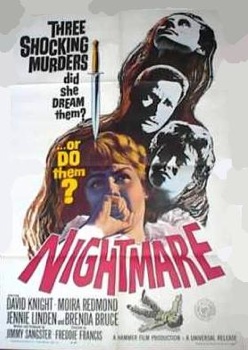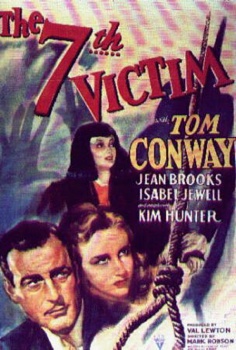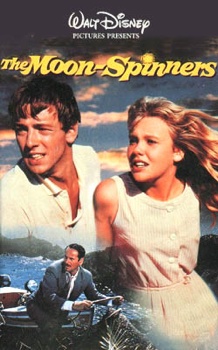 History
History  History
History  Pop Culture
Pop Culture 10 Cases of Grabbing Defeat from the Jaws of Victory
 History
History 10 Common Misconceptions About the Renaissance
 Weird Stuff
Weird Stuff 10 Crazy Things Resulting from Hidden Contract Provisions
 Facts
Facts 10 Unusual Facts About Calories
 Weird Stuff
Weird Stuff 10 Days of Humiliation When the Person Should Have Stayed in Bed
 Humans
Humans 10 Surprising Ways Game Theory Rules Your Daily Life
 Food
Food 10 Popular (and Weird) Ancient Foods
 Animals
Animals Ten Bizarre Creatures from Beneath the Waves
 Technology
Technology 10 Unexpected Things Scientists Made Using DNA
 History
History 10 Events That Unexpectedly Changed American Life
 Pop Culture
Pop Culture 10 Cases of Grabbing Defeat from the Jaws of Victory
 History
History 10 Common Misconceptions About the Renaissance
Who's Behind Listverse?

Jamie Frater
Head Editor
Jamie founded Listverse due to an insatiable desire to share fascinating, obscure, and bizarre facts. He has been a guest speaker on numerous national radio and television stations and is a five time published author.
More About Us Weird Stuff
Weird Stuff 10 Crazy Things Resulting from Hidden Contract Provisions
 Facts
Facts 10 Unusual Facts About Calories
 Weird Stuff
Weird Stuff 10 Days of Humiliation When the Person Should Have Stayed in Bed
 Humans
Humans 10 Surprising Ways Game Theory Rules Your Daily Life
 Food
Food 10 Popular (and Weird) Ancient Foods
 Animals
Animals Ten Bizarre Creatures from Beneath the Waves
 Technology
Technology 10 Unexpected Things Scientists Made Using DNA
10 Mystery or Suspense Movies You Must See
These films, for the most part, aren’t at all obscure—some of them are downright classics, and many of you may have seen some of them. But they aren’t the films that leap immediately to mind when the average person walks into the video store and heads for the “Suspense” section.
Still, there’s some true gems here that deserve to be seen and remembered. So next time you stroll into Blockbuster or send away to Netflix and have an urge to see a mystery or thriller, skip the contemporary stuff just once, and try one of these.
This crossword puzzle of a movie is one of the most remarkable murder mysteries ever made. The entire movie plays like a game; indeed, it’s all about a game being played by a group of bite-you-in-the-back friends who have subjected themselves to a week’s vacation aboard the yacht of a sadistic egotist (James Coburn) who derives enjoyment from humiliating his guests. While they play their amateur detective game, trying to uncover each other’s assigned “secrets,” one of the group, it seems, is playing for real—because it looks as though their host is trying to blame one of them for the hit-and-run killing of his wife a year before.
If you enjoy board games, puzzles, and thinking fast on your feet, this movie will keep you interested—and guessing—right up to the final minutes. Sole liability: 70s fashion styles throughout. Offset by a fantastic cast: James Mason, Raquel Welch, Dyan Cannon, Coburn, Richard Benjamin, Joan Hackett
Second in the series of films in which Michael Caine plays Harry Palmer, Len Deighton’s ordinary-guy-as-unwilling-spy (the previous film, “The Ipcress File,” is a must-see as well). Palmer, former army sergeant, is caught in some unnamed crime, and given a choice—work for British intelligence, or go to the stockade. This film sends Palmer to Berlin to oversee the defection of a cynical Russian general (“Americans? Bah!” The general says to Palmer’s suspicions about why he doesn’t offer himself to the Americans instead, since they have more money to offer him. “They’re revolutionaries gone decadent. They’re Russians in blue jeans.”) In the process Palmer meets up with an untrustworthy old German friend and a beautiful Israeli operative, and gets framed for murder. Is the Russian up to something, or is he on the level? And what do the Israelis have to do with it?
One of the best and most realistic spy movies of the 60s (this isn’t some flashy, gadget-laden James Bond flick), with humor, tension, and a riveting dark side.
In the 1950s and 60s, Britain’s Hammer Films was known for their lush, Technicolor horror movies—latter day (and gorier) takes on the classic old Universal Studios monster movies. Beginning with remakes of Dracula and Frankenstein, Hammer went on to revive mummies and wolfmen, zombies and phantoms, and stretched out Christopher Lee’s indestructible Dracula and Peter Cushing’s morally-challenged Frankenstein into multi-film series.
For a time Hammer also delved into psychological thrillers, and “Scream of Fear” is perhaps the best of these. The film begins with a pretty girl being fished out of a Swiss lake, victim of a drowning. We learn she was the friend and care companion to beautiful (and morose) Susan Strasberg, who has been confined to a wheelchair after a riding accident. Mourning the loss, Strasberg makes the journey to see her estranged father for the first time in ten years at his hilltop Riviera estate. Met at the airport by a handsome and sympathetic chauffeur, she learns that her father has unexpectedly gone away on business, due to return in a few days’ time. The chauffeur hints at something mysterious going on, and Strasberg begins to suspect her new stepmother of plotting her father’s murder along with the local doctor (played by Christopher Lee). Her suspicions turn to paranoia—and perhaps madness—when she begins seeing her father’s corpse in the house—only to discover it gone when she comes back with help. Is her father really dead? And if he is—who killed him? Or is she simply losing her mind?
This film made a lasting impression on me when I was a kid—I saw it once—and only once—on a Saturday afternoon on local television, and it gave me nightmares. 30+ years later I had forgotten most of the plot, but still remembered a scene where the chauffeur dives to the bottom of a weed-choked pool and finds the old man’s corpse hidden there, staring out emptily with wild, open eyes. Years later I sought help on the internet from a fellow classic horror-movie buff, who quickly identified what film this memory came from—and within a week I had my own copy from eBay. The thrill of seeing this riveting picture again after all those years made me damn grateful for the ‘net and how it makes the re-discovery of old gems possible.
I can’t recommend this film enough. Not a great work of art, just a tense, chilling, and edgy psycho-thrill with a hint of ghost story and an unexpected twist at the end.
Really a classic that any old movie buff will have heard of and seen—but since we’re in a post-literate age, it seems like almost all old films are candidates for re-discovery—especially when there’s no longer much incentive for young people to check out old movies on TV anymore, with hundreds of cable channels making it easy to avoid the challenge of giving old cinema a chance. Things were different thirty-five years ago when all we had were a mere handful of local TV stations—network affiliates of the Big Three—NBC, CBS, and ABC… as well as PBS…and nothing else. If you wanted to watch TV, sometimes you HAD to sit down and try to get into an old movie—especially since that was all that was on during many afternoons.
Anyway, this great film, told partly in flashback, presents Peter Lorre as a crime novelist who by chance meets a Turkish police detective who for years has been chasing a murderer, spy and terrorist named Dimitrios, whose dead body recently washed ashore in Turkey. Lorre is taken to see Dimitrios’ body, and is told some of the story of how this petty criminal became one of the most wanted men in the Near East. Lorre becomes fascinated with this character, and decides to start writing a book about Dimitrios. This takes him on a trip around Europe, from Greece to Switzerland to Paris, interviewing various people who had encounters—and even had their lives ruined—by the unscrupulous and dangerous Dimitrios. Along the way he finds himself partnered with a mysterious man (Sydney Greenstreet) who turns out to be one of Dimitrios’ former criminal colleagues, betrayed to the police by Dimitrios years before. After speaking with Lorre, Greenstreet finds reason to believe that the slippery Dimitrios is actually still alive, and involves Lorre in a scheme to blackmail the slippery master criminal and spy.
Another tense Hammer psycho-thriller, Nightmare is the story of a school girl who, years before, had witnessed her insane mother stab her father to death. Emotionally fragile and obsessed by this horribly traumatic incident, the girl begins having terrible nightmares which eventually cause her to be sent home from boarding school accompanied by a sympathetic teacher. Once there she enters into the care of her guardian, the old family servants and a hired nurse—but despite the presence of these familiar and caring faces, the girl’s nightmares worsen, and she begins seeing a spectral woman wandering the house at night. Believing she’s going mad like her mother, her hold on reality plummets… until a tragedy occurs. But even then we learn there’s more to the story than mere madness.
Twisting, creepy, and reeking with betrayal, this is a neatly disturbing little thriller worthy of the Hammer name.
There was something about the 1970s and realistic, gritty crime dramas. They just went together. “The French Connection” films, “the Godfather” films, “Serpico,” “Dog Day Afternoon”… even “The Yakuza”… and then there’s “The Taking of Pelham One Two Three.” While in the same league as these other great films, what makes “Pelham” different is that it takes itself just a *shade* less seriously—at least at times. It even stars Walter Matthau as a Transit Police officer, and of all people, Jerry Stiller as a cop. It shouldn’t be a surprise, then, that there’s the occasional light moment to relieve the tension.
But this is no comedy–not by a long shot. It’s an extremely tense and even violent thriller with moments of shock and terror. A group of ruthless and highly organized men (led by the quintessential Quint of “Jaws,” tough guy Robert Shaw) hijack a New York City subway car, and threaten to kill the passengers one by one unless a ransom is paid. Working frantically against the hijackers’ deadline, Matthau and his detectives are stymied at every turn by Shaw, who seems to anticipate every move they make.
Creepy and ambiguous, “Klute” is the film that made Jane Fonda a serious actress (prior to this she’d starred mostly in light comedies and, of course, had played the title space-vixen in the sci-fi/soft-core cult flick, “Barbarella”) and even managed to redeem her reputation (slightly) from the harm done it by her pro-Vietcong antics a couple years earlier.
Hired by a company CEO to investigate the disappearance of a fellow executive, private detective John Klute (Donald Sutherland) soon discovers that the missing man may have had something to do with the brutal torture-murder of a hooker. Klute traces the man’s movements (and prior patronage) to a group of prostitutes working for pimp Roy Scheider. One of the hookers in particular seems to have information about the killer—Bree Daniels (Fonda)–and seems, also, to be next on his list.
In between moments of truly chilling tension, the film delves into the personal life of Fonda’s character, who’s trying to get out of the call-girl life (her therapy sessions serve as a centerpoint) and her ambiguity towards strait-laced and protective Klute, whom she is both attracted to and disdainful of. All the while the killer is getting closer, clearly stalking Fonda.
In the 1940s, RKO Pictures, one of the major Hollywood studios, had fallen on hard times due to their bankrolling of Orson Welles’ extravagant (if artistically brilliant) “Citizen Kane” and “The Magnificent Ambersons.” Neither film had recouped its cost at the box office, putting RKO in jeopardy. The studio needed to get back to making cheap, but profitable movies. Noting the huge success rival Universal Studios was having with the horror genre, RKO decided they wanted a piece of the fright action. But what producer could outdo Universal at its own game, for a fraction of the cost?
Enter Selznick Studios chief script editor Val Lewton. Lewton, who had worked on “Gone With the Wind” as well as a number of other Selznick properties, had grown tired of playing second banana to David O. Selznick’s Hollywood mogul. Lewton wanted a chance to play the mogul himself; and RKO gave him the ideal opportunity.
Or so he thought. Lewton *was* given full power to produce some low-budget “B” horror pictures, but also found himself saddled with the cheesy titles that RKO had dumped on him. (It was common practice in those days for a studio to hand a producer a title, or at most a title and concept, and he then had to go away and come up with a story to go with it). Lewton proved his genius, however, by taking low-grade concepts and titles “Cat People” and “I Walked with a Zombie,” and turning them into minor moody masterpieces of suspense and horror.
“The Seventh Victim” was another of Lewton’s highly successful and brilliant “B” films. The story of devil worshipers in New York City who have marked an errant member for death, the film moves from noir-ish mystery to darkly sad exploration of futility. What makes the film such a delight to watch are the memorable bits of tense imagery (a threatening hand touching the heroine’s hand from around a dark alleyway corner; an empty apartment with a single chair positioned directly under a noose; a murder occurring off-camera, down a dark hallway) and the moody, tragically-tinged performance of Jean Brooks as the beautiful, depressed victim of the Satanists, being driven hard to take her own life to pay the price for betraying the group.
Seemy film noir with the great Robert Ryan as a racist bank robber, enlisted by criminal old-timer Ed Begley for one last big heist—though it involves Ryan having to partner with inside man Harry Belafonte to make the job happen. Of course part of the tension comes from the electric hostility going on between Ryan and Belafonte, but underscoring this is the need for Begley to pull off a final, successful robbery. The team works carefully to make sure every aspect of the job comes off right—timing it to the minute—but of course something goes wrong.
Ryan’s performance takes this film to a higher level (Belafonte is also excellent) and it becomes impossible not to identify, a little, with this unsavory character—or to not get caught up in the tension and danger of the crime the group is trying to pull off.
One of the best scenes: Ryan beats the crap out of a young and cocky Wayne Rogers in a bar.
Okay, bear with me on this one. This is the lightweight entry, and one for the kids—but enjoyable for adults too, if they put a little effort into it. Plus, I only had nine titles and needed a tenth. Still, this is an enjoyable little romance/mystery worth seeing at least once. It IS a little suspenseful (sometimes)… and IS a thriller (of sorts)… if a fluffy one. And yes, it’s a Disney film.
Now, ordinarily I detest Disney, but this one’s from back in the day (1960s) when Disney produced some decent (if ultimately forgettable and yes—totally lightweight) live action films. Nothing to make anyone’s top ten list mind you (this isn’t a top ten list after all)… just entertaining time wasters. Best by far in this category was Disney’s excellent version of “Treasure Island,” while the worst was… well, take your pick. “That Darn Cat,” maybe? “The Apple Dumpling Gang?”
But “The Moon Spinners” is closer to the “Treasure Island” end of the scale, if not quite in the same (relatively) rarified air. Disney contract player Hayley Mills (I had a boyish crush on Hayley back then) on vacation in Greece, meets up with a mysterious young man who turns out to be the former employee of a London banking house, who is chasing a group of international jewel thieves in hopes of clearing his name (they framed him). Okay, sounds hokey right? And it is. But it’s also fun, and richly photographed, and you can’t beat the Greek location for timeless beauty. It even stars Eli Wallach as the villain.
Contributor: Randall












